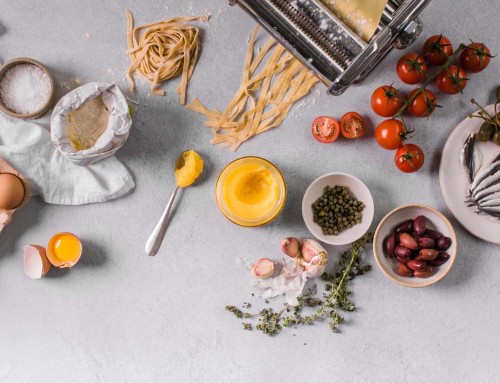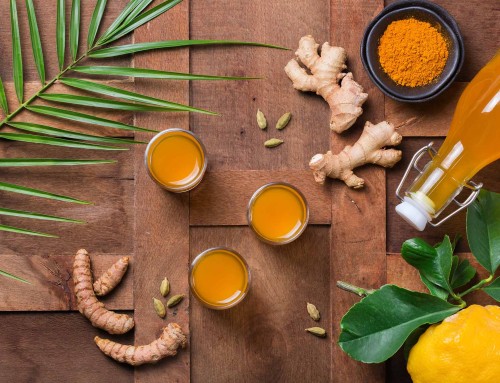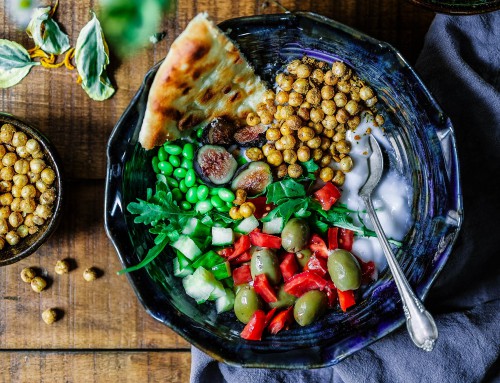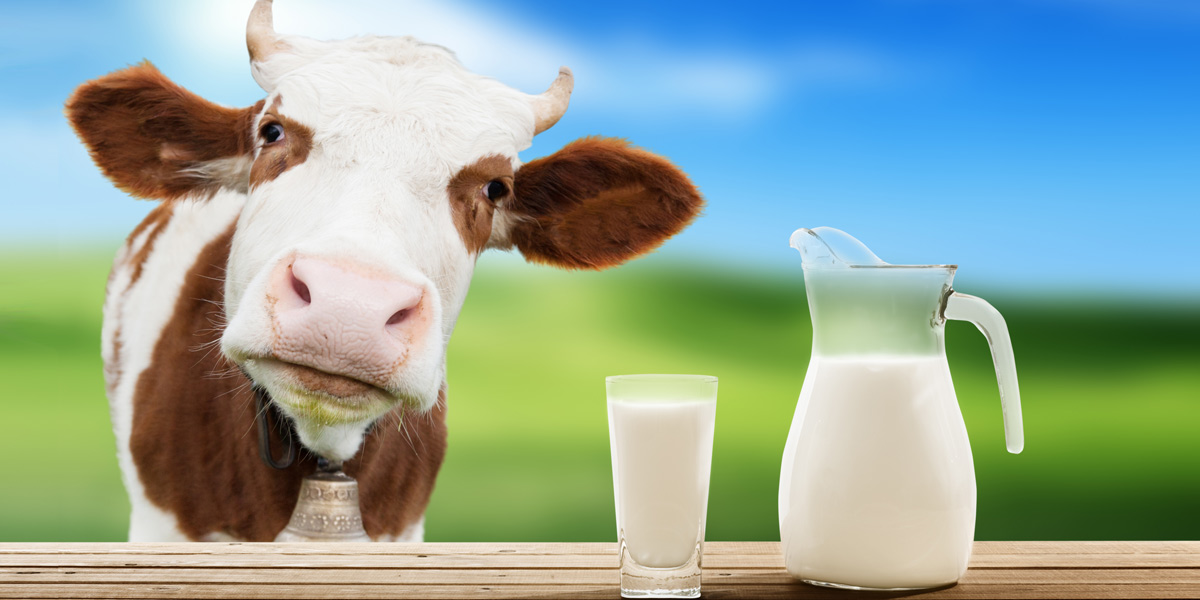
When I was growing up, cow’s milk was hailed as a complete food and essential for growing children. These days, milk allergies and lactose-intolerance have become a major issue; concerns are voiced about its saturated fat content; and many people cite ethical issues around how we treat dairy cows as a reason to avoid milk.
Let me put my own cards on the table. Despite its potential problems, I still consider milk a good thing, but add a caveat – how much of a good thing depends on how close it is to the milk our ancestors drank.
 When I look down any supermarket’s shelves, I never see my ideal milk. Instead I see a spectrum from deeply bad (sterilised or UHT), to bad (homogenised), to not that bad (non-homogenised), and sometimes quite good (organic, non-homogenised and A2).
When I look down any supermarket’s shelves, I never see my ideal milk. Instead I see a spectrum from deeply bad (sterilised or UHT), to bad (homogenised), to not that bad (non-homogenised), and sometimes quite good (organic, non-homogenised and A2).
I admit to being fussy about milk and there are several things I require from it. My ideal milk would be:
- non-pasteurised
- non-homogenised
- A2 protein
- from organically raised, grass-fed cows that have not been subjected to antibiotics and that have spent most of the year out of doors grazing in fields.
Really, what I want is the type of milk we human beings have consumed for thousands of years. Yet it’s taken me a long time to locate a regular supply of such milk.
Does pasteurisation create a dead product?
 Pasteurisation was named after Louis Pasteur, the discoverer of the germ theory of disease, and is applied during the processing of drinks such as wine, beer, carrot juice, fruit juices and milk. It involves the application of heat to kill off any bacteria that can cause early spoilage, and to prevent the substance turning sour. There are fears that milk may also a potential transmitter of certain diseases, such as a tiny percentage of tuberculosis cases. The unsanitary conditions typically found within a dairy before the modern era were an ideal breeding ground for such pathogens.
Pasteurisation was named after Louis Pasteur, the discoverer of the germ theory of disease, and is applied during the processing of drinks such as wine, beer, carrot juice, fruit juices and milk. It involves the application of heat to kill off any bacteria that can cause early spoilage, and to prevent the substance turning sour. There are fears that milk may also a potential transmitter of certain diseases, such as a tiny percentage of tuberculosis cases. The unsanitary conditions typically found within a dairy before the modern era were an ideal breeding ground for such pathogens.
Older milk pasteurisation methods involved heating milk to temperatures below boiling point. Newer methods – known in the dairy industry as High Temperature/Short Time (HTST) – use much higher temperatures for a shorter length of time. This process kills any harmful bacteria that could be present in the milk, but there are numerous beneficial bacteria and enzymes in raw, unpasteurised milk that are also lost. There is also an Ultra High Temperature (UHT) process that heats the milk to 280°F for about two seconds, and eliminates a larger percentage of bacteria than HTST pasteurisation. UHT milk can sit unrefrigerated on a supermarket shelves for extended periods of time without spoiling.
Besides removing any beneficial probiotic bacteria that milk contains, there is also some vitamin and mineral loss during any pasteurisation process. Milk is potentially a rich source of calcium, and that is why it has been traditionally seen as essential for a growing child, yet pasteurisation makes most of its calcium content insoluble and therefore of little use in supplying our bones with this essential building block.
All the Ayurvedic practitioners (Vaidyas) I have met recommend eating foods that are unprocessed and as close to nature as possible, and that milk should be unpasteurised and non-homogenised. From the Ayurvedic standpoint, pasteurisation is a cooking process that creates a milk devoid of Prana (life-force) and that can create Ama (toxic by-products).
Pasteurise you own milk the Ayurvedic way
Ayurveda recommends milk be heated just before use. The logic given for this is that milk, with its cold, heavy, oily nature, is difficult to digest and heat makes it lighter and easier to assimilate. Ayurveda also recommends that spices, such as ginger, cardamom, cinnamon and turmeric, be added to further decrease its cold, heavy and oily Gunas (qualities) and increase its digestibility.
How, you may ask, does the heating of milk just before drinking differ from pasteurisation? The difference is one of freshness.
In general, Ayurveda recommends cooked over raw food – although some enzymes and vitamins are lost in the cooking process, the resulting food becomes easier to digest and the remaining nutrients are more easily absorbed. Yet, Ayurveda does not recommend eating cooked food that has been stored away. Such ‘old’ food is said to produce toxic Ama in the body and modern research has shown that cooked food oxidises when left for any length of time.
One Ayurvedic Vaidya I met explained that when you drink pasteurised milk you are drinking something that has been cooked and left around on supermarket shelves and in fridges. He said that Ayurveda would consider such milk devoid of life and with virtually no Prana (life-force). You are also eating millions of old dead bacteria that were present in the original milk. It is recommended to drink raw milk immediately after ‘cooking’ it, while the milk is still fresh.
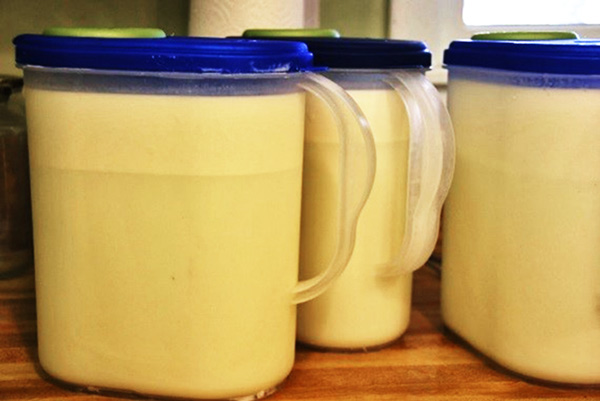 Why doesn’t cream float to the top anymore?
Why doesn’t cream float to the top anymore?
I’ll tell you a guilty secret. When I was a boy, I would get up before the rest of my family, bring in the delivered milk and pour the cream settled at the top of each bottle onto my breakfast cereal. Due to a process called homogenisation, these days you would be hard pressed to find a bottle of milk that will allow this indulgence.
First invented by a Frenchman called Auguste Gaulin in the 1890’s, the homogenisation process is applied after milk is transported from farm to factory and that has then been taken through the pasteurisation process. Gaulin patented a machine that broke milk’s fat globules into a smaller, more uniform size, thereby resisting separation and rising.
To create smaller and smaller fat globules, modern homogenisation machine subject milk to massive pressure – usually 2,000-3,000 pounds per square inch (psi), though some processors apply up to 14,500psi or higher. The extreme pressures homogenisation places on the fat particles can lead to oxidisation and rancidity.
Our liver is the organ that breaks down fat so that its components can be properly absorbed and used throughout the body. It is considered that the ultra-fine fat particles created by homogenisation are so tiny that they can easily bypass the normal digestive system by going through the walls of the digestive tract and straight into the blood stream. Having undigested fat floating around the bloodstream can trigger the immune system and lead to inflammatory and allergic responses.
From the Ayurvedic standpoint, homogenised milk is considered more difficult to digest than the non-homogenised variety and tends to clog the finer channels of circulation.
A1 or A2, that is the question
A couple of years ago I found a milk supplier that fulfilled all my milk requirement, bar one. They only had A1 cows and no A2 cows. More recently I discovered my holy grail of milk on a farm near Crewe. This family-run dairy farmer is run by ‘real milk’ enthusiasts. They told me I can choose between A1- or A2-protein milk and of course I ask for A2.
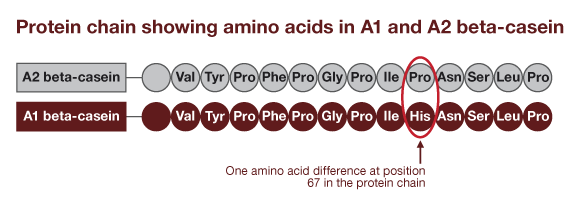 Now, what is A1- and A2-protein all about?
Now, what is A1- and A2-protein all about?
Several thousand years ago there was a genetic change within some cow breeds in Northern Europe, that affected the beta-casein protein in their milk. This genetic change resulted in breeds producing milk with mostly A1 beta-casein – this included breeds such as Holstein Friesian (the black or brown and white cows that you usually see grazing in fields), Ayrshire, and British Shorthorn. Older breeds, such as African and Asian cows, and European breeds, such as Guernsey, Jersey, Charolais and Limousin, produce only A2 beta-casein milk.
Does this matter? Some studies indicate that A1 beta-casein may be harmful to health, and that A2 beta-casein milk is the safer choice. In this article, I will not burden you with the evidence in favour of A2 milk, but if you want more information, and a comprehensive list of links to studies on this subject, go to https://authoritynutrition.com/a1-vs-a2-milk.
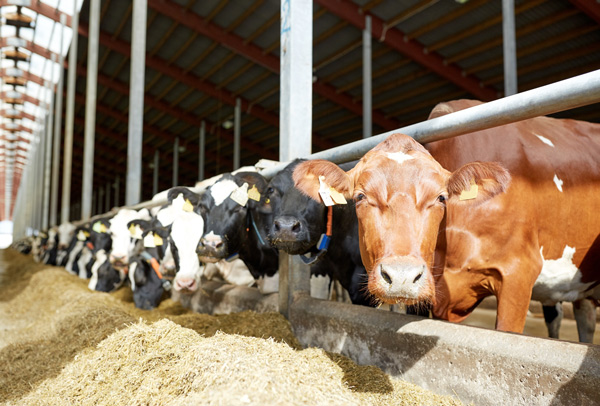 Aren’t all UK cows grass-fed?
Aren’t all UK cows grass-fed?
Last year I spent a few days in a farmhouse B&B on the glorious coast of Pembrokeshire. The farmer told me he used to have a dairy herd but, like many other small farmers in the UK, he was defeated by the ludicrously low milk prices placed on dairy farmers by our supermarkets and he ended up having to sell his herd. To stay economically viable, dairy farming is increasingly being forced down the industrial feedlot model; even in beautiful Pembrokeshire.
First pioneered in the US, where over 90% of all milk comes from such systems, feedlots are increasingly being adopting throughout Europe and the UK. In the US and increasingly throughout Europe, farms with fewer than 200 cows are disappearing, while the number of very large industrial feedlot farms with 2,000 cows or more have been increasing. The largest operations in the USA have over 15,000 cows.
These days, dairy cows can spend virtually their whole lives without eating or sometimes even seeing a blade of green grass. Some of these operations take place in large barren and crowded outdoor lots. In other cases, cows are kept indoors throughout the year, in high-density conditions.
When lactating, cows are often tied up in stalls where they show signs of stress from social isolation and the inability to lie down. In such stressful and crowded conditions, they are very susceptible to disease (one of the most common being mastitis, where the udder becomes infected and releases pus into the milk). The result is that in a conventional dairy system, cows are given a regular supply of antibiotics. Conveniently, antibiotics also happen to increase milk yield, so in non-organic systems cows are often given antibiotics whether they need it or not.
5 reasons to go Organic
There are many reasons for choosing organic – from reduced presence of pesticides in the environment, to avoiding the build-up of dangerous chemicals such as the herbicide glyphosate in your body, to taste, to wildlife conservation, nutritional benefits, and health benefits. Many of us are concerned that the animals who supply our meat and dairy needs have a good, healthy life. Organic standards, such as those demanded by the Soil Association, are designed to ensure the highest animal welfare standards available.
According to the Soil Association, organic means that animals:
- Must have access to pasture (when weather and ground conditions permit) and are truly free range.
- Must have plenty of space – which helps to reduce stress and disease
- Are fed a diet that is as natural as possible and free from genetically modified organisms (GMOs). Over a million tonnes of GM crops are imported each year to feed the majority of non-organic livestock which produce chicken, eggs, pork, bacon, milk, cheese etc. This practice is banned under organic standards
- Graze and forage naturally on organic pasture (grasses and other crops) where only natural fertilisers are used and pesticides are severely restricted
- Must not routinely be given antibiotics. Farm animals now account for almost two-thirds of all antibiotics used in the EU. These are passed to us through the food chain.
All this extra care means organic milk is more expensive to produce. Average milk yield in an organic dairy is about one third less than in a non-organic system – after all, cows fed on concentrated feed produce more milk. But both the confined conditions and the unnatural feed can be stressful for the cow and puts a strain on the animal’s health.
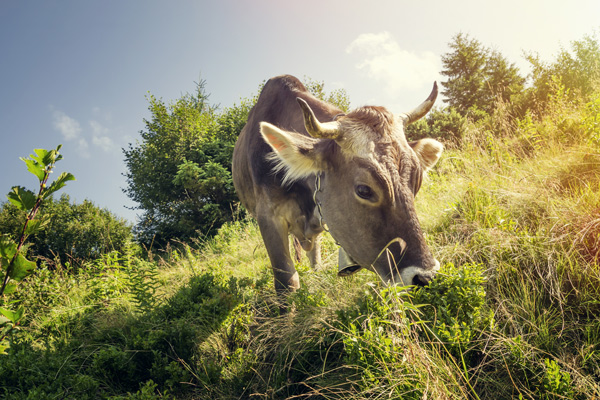 Cows need Omega-3-rich grass
Cows need Omega-3-rich grass
To stay healthy, it is essential that we supply our body with the right type of oils. The right balance of Omega-6 fatty acid and Omega-3 fatty acid in these oils is also critical, but in the industrialised world, that balance is way out of balance.
Research on the diet of non-industrial populations has shown a typical ratio of Omega-6:Omega-3 oils that ranges between 4:1 and 1:4. Hunter-gatherers who mostly ate land animals had a ratio of 2:1 to 4:1. Inuit tribes, who mostly ate Omega-3 rich seafood, had a ratio of 1:4. Other non-industrial populations had an Omega-6:Omega-3 ratio somewhere in between.
In industrial countries, such as the UK, it is estimated the Omega-6 to Omega-3 ratio is more like 16:1.
While our body needs both types of fatty acids, Omega-6 stimulates our body’s inflammatory response, while Omega-3 has an anti-inflammatory effect. This means that most people who live in westernised countries suffer from an over-active inflammatory response. Excess inflammation may be one of the leading factors behind many of the serious diseases we are dealing with today, including arthritis, diabetes, metabolic syndrome, heart disease, Alzheimer’s and different types of cancer.
Interestingly, soya bean oil has a very high ration of Omega-6 fatty acids. Not only is soya and soya oil found in numerous processed foods, but soya is a major ingredient in the animal feed given to cows to stimulate growth and increase milk production. It is little wonder that milk and other dairy products that come from the non-organic conventional systems are usually high in Omega-6 and low in Omega-3.
Cows in organic systems, that mostly eat grass and field herbs and that avoid the unnatural feeds used in conventional systems, produce fat that has a more balanced Omega-3 to Omega-6 ratio.
4 benefits of raw milk
1. Reduces allergies
Research suggests that children who drink raw milk are 50% less likely to develop allergies and 41% less likely to develop asthma compared to children who don’t.
A study involving 8,000 children on various diets, was published in the Journal of Allergy and Clinical Immunology. One of its conclusions was that children who drank raw milk experienced ‘naturally immunising’ effects.
Many other studies carried out over the past 100 years have shown that raw milk supports and benefits growth and development, including supporting skeletal growth. They have also found increased immunity against infections, and better dental health.
2. Helps with skin health
Dairy products have a bad reputation when it comes to causing or exacerbating skin inflammation and acne. But this does not seem to be the case with raw milk, which seems to benefit the skin. Those who consume raw milk report improvements in conditions such as acne, eczema and psoriasis.
This is probably because raw milk contains large amounts of health-promoting saturated fats and omega-3 fats, which support hydration of the skin. Some people don’t just consume raw milk, but use it as a topical moisturiser. To maintain their beautiful complexions, the Queen of Sheba and Queen Cleopatra were said to bathe in ass’s milk. For thousands of years, raw milk massage has been used for skin health in India. Goat milk soap bars are popular in Europe and recipes for homemade moisturising face creams using raw milk are common on the internet.
Imbalances in your gut flora can lead to inflammation and contribute to skin problems such as acne and eczema. The natural probiotics present in raw milk can help balance gut bacteria, which can lead to better skin health.
3. Helps supply essential nutrients
A single serving of raw milk contains about 400 mg of calcium, 50 mg of magnesium and 500 mg of potassium. These minerals are vital for hydration, cellular function, blood circulation, building bone density, muscle health, detoxification, and metabolism. They also happen to be the three minerals many children and adults are deficient in.
4. Can create probiotic foods
Probiotics are microorganisms that line the gut wall and support the absorption of nutrients. They also help protect your body from foreign invaders such as parasites and E. coli. Raw milk products, such as yogurt, cheese and kefir are excellent dietary sources of probiotics.
Disorders that probiotic foods can help with:
- Inflammatory bowel disease
- Intestinal infections
- Colon cancer
- Diarrhea
- Urinary tract infections
- Weak immune system
- Irritable bowel syndrome
- Skin infections
- Yeast infection of the vagina
Notes
* The Friesian breed was introduced into the UK in the mid 19th century. The Holstein was brought in after the second world war.



